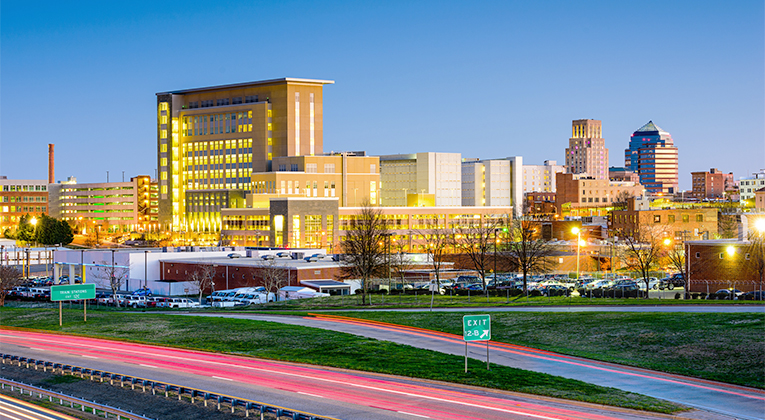In 2022, the Research Triangle region in Raleigh, Durham and Chapel Hill, North Carolina, was declared to be the fourth leading hub for biotech in the U.S., behind Boston, San Francisco and San Diego. Some of the biggest names in pharma have a presence there—including Novo Nordisk, Purdue Pharma, GSK, Merck, Amgen, Biogen and Pfizer—and while the area boasts “the world’s largest cluster of CROs,” coming in 4th place may have more to do with the lack of true lab-ready real estate than overall size of the market.
Unlike its biotech counterparts in other cities, the approximate 10.6 million square feet of R&D lab space in the Raleigh-Durham market still has nominal availability. The three research universities which give the “Triangle” its name—Duke University, the University of North Carolina at Chapel Hill and North Carolina State University—play a vital role in the life science ecosystem. The companies which spin out of these institutions play a material role in keeping both the sublease market and direct available lab space low. For the most part, increases in remote work don’t really play a role in this sector. In other major life science markets, a combination of lab facilities being overdeveloped, record high fundings and companies grabbing any space they could for planned future growth (which is now back on the market via sublease or default) have led to record-high availability. Not yet the case in the Triangle.
“Raleigh-Durham is considered one of the major biotech hubs, but in comparison to markets like Boston and San Diego, we are not as large and haven’t experienced the market shifts on the same scale,” says Edwin Yarbrough, executive vice president of Hughes Marino, who founded the firm’s Raleigh-Durham office. “In a recent life science sublease report we prepared, we found that while other cities have millions of square feet on the market, we didn’t. We had four subleases and a few spec suites. We’re seeing these numbers increase but nowhere near what we see in San Diego and Boston.”
Getting Ready as New Space Comes Online
The Triangle is a unique market where almost every single-story “flex” building carries a “R&D/Lab” label. Some have been converted by experienced life science landlords, some are just proposed R&D space by landlords who want “in on the action” and some fall in between. Biotech and life science companies looking to renew leases, secure new space, expand, contract or renegotiate existing leases in the Triangle need an experienced advisor to help navigate the offerings and leverage available options—so they can act quickly when the right space and opportunity presents itself.
With limited options—particularly for companies looking for new spaces with extra amenities like coffee bars, food services, breweries, rooftop decks and fitness facilities, or even GMP-ready lab spaces with the requisite HVAC, plumbing, ceiling height and electrical—it’s essential to have someone who has a detailed understanding of the options, availability and landlords tenants will rely on to operate these critical high functioning buildings.
Despite seeing weakened demand, new R&D space continues to come online mostly in the RTP/I-40 corridor. The Triangle region’s first high-rise lab building, known as Via Labs, will be part of a gleaming central hub in RTP known as HUB RTP. Via Labs will reach eight stories high and feature 265,000 square feet of highly amenitized R&D space.
The developer, Longfellow Real Estate Partners, is awaiting an anchor tenant to begin construction on the $1.5B project, but it points to the future vision of RTP being a much more dense, multi-use urban environment offering everything from housing to retail and restaurants, in addition to ample lab and workspace.

With lab space still at a premium, says Yarbrough, companies looking to renew, relocate, contract or expand to (or within) the Triangle need a knowledgeable advisor to navigate the landscape and understand the delta between what is publicly offered and where transactions actually end up after well executed negotiations. “Part of the value we bring to the table is being able to identify spaces that are off-market but may come online soon or have existing tenants in place looking for an exit. It is critical to work with someone who has those relationships and knows the full landscape, while providing objective, conflict-free advice. It’s imperative to have a strong negotiator and advisor that will challenge the status quo, especially in an environment that is changing weekly to be more favorable for tenants. Windshield mindset vs. rearview mirror.”
Beyond finding the space, life science and biotech clients also need expertise to secure the best terms and transaction structure. “There is so much capital investment made into the infrastructure of these lab spaces,” Yarbrough says. “Who provides what is negotiated heavily.” Hughes Marino specializes in working on behalf of the tenant to ensure the landlord or developer will support the necessary high-cost improvements, including updates to heating and cooling systems, ventilation systems, plumbing and waste systems and electrical systems, before any tenant dollars are applied. “Scientists who are founders and CEOs are no match for professional landlords in the world of real estate transactions, what they can negotiate, and who is financially responsible for what. How do we maximize our client’s negotiated tenant improvement allowance? How do we keep our client’s capital investment into the space as low as possible? What can we do to improve the bottom line so our clients can invest more into research and recruiting top talent? These are the questions we constantly think about,” he adds.
North Carolina’s Mini Cambridge
Over the past decade or more, downtown Durham has evolved into a highly desirable “mini Cambridge,” says Yarbrough, with companies, startups and academic institutions working at the intersection of science and technology, as well as a thriving arts scene, nightlife, walkable streets and world-class restaurants.
A $500M 10-acre new Heritage Square development with two towers is currently in the works and will offer luxury housing, Class A office and lab space, plus retail and restaurants. It’s the first piece in a multi-step development project. In addition, Longfellow is anxiously awaiting to break ground on a new 200K SF lab building as part of their Durham ID master plan.
There are also 21 new developments, according to a 2023 State of Downtown Durham report, which will add more than 2,300 new housing units to the downtown. And the city is increasing pedestrian-friendly improvements, like a park and Durham Rails Trail. This trail will be an important part of the larger 3,000 miles East Coast Greenway that stretches from Maine to Florida.
While Durham may not yet have reached “Cambridge levels,” there’s significant interest and real momentum happening along with continued development and improvements that make it a real draw for startups and biotech companies looking to be part of the excitement.
With the right real estate partner, and enough time to run a proven process, says Yarbrough, companies can secure both great space and terms, allowing them to create the culture to attract, recruit and retain world-class talent.
“As the case with any real estate project, it’s always better to start sooner rather than later,” he says. “Start the process at least two years out—don’t wait until the last year of the lease. Allowing time to force decisions rarely results in the desired outcomes.”








